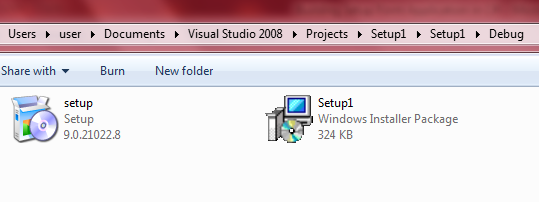

- HOW TO CREATE INSTALLER FOR WINDOWS APPLICATION HOW TO
- HOW TO CREATE INSTALLER FOR WINDOWS APPLICATION INSTALL
- HOW TO CREATE INSTALLER FOR WINDOWS APPLICATION PASSWORD
- HOW TO CREATE INSTALLER FOR WINDOWS APPLICATION DOWNLOAD
- HOW TO CREATE INSTALLER FOR WINDOWS APPLICATION MAC
You'll get to see Application Folder, User’s Desktop and User’s Program Menu. Now open the file system editor by clicking on the project and select the option to open file system editor, like in below figure: The project will be added to the solution. Right click on the solution and add a new project to your solution like in following figure:Īnd add a setup project by Other project Types->Setup and Deployment->Visual Studio Installer Now let’s create an installer for the same windows application. Just wanted to write few lines of code, so I binded the button’s click event to show text box's text Decorate the control properties however you want. I gave the name CreatingInstaller to my windows application, obviously you can choose your own.Īdding a new Windows Form Application in my solution and adding a text box and button to the default form resulted in the figure as shown below. Start the Showįirst, let’s create a simple one form windows application, with only a text box and a button.Ĭreating a windows application is just for the sake of having one to install. In this article I would like to explain a step by step process to create a windows application and a setup installer for the same in a very simple manner, that is easy to understand and follow knowing that there are a number of other ways to do the same thing. And guess what, they successfully found bugs in that too. The driving force for me to write this article is my QC team, who accept the main application for testing, and who also verified my setup installer with their 100% effort. There are numerous articles I found explaining to create a setup project, but some did not work, and some did not have a live example to follow.
HOW TO CREATE INSTALLER FOR WINDOWS APPLICATION HOW TO
You can now quit Terminal and eject the volume.There are number of ways provided by Microsoft to create a setup project for windows application.īut when I started to create one, I got nothing but queries and confusions of how to start and where to start.
HOW TO CREATE INSTALLER FOR WINDOWS APPLICATION INSTALL
HOW TO CREATE INSTALLER FOR WINDOWS APPLICATION PASSWORD
HOW TO CREATE INSTALLER FOR WINDOWS APPLICATION MAC
* If your Mac is using macOS Sierra or earlier, include the -applicationpath argument and installer path, similar to the way this is done in the command for El Capitan. Sudo /Applications/Install\ OS\ X\ El\ Capitan.app/Contents/Resources/createinstallmedia -volume /Volumes/ MyVolume -applicationpath /Applications/Install\ OS\ X\ El\ Capitan.app Sudo /Applications/Install\ macOS\ High\ Sierra.app/Contents/Resources/createinstallmedia -volume /Volumes/ MyVolume Sudo /Applications/Install\ macOS\ Mojave.app/Contents/Resources/createinstallmedia -volume /Volumes/ MyVolume Sudo /Applications/Install\ macOS\ Catalina.app/Contents/Resources/createinstallmedia -volume /Volumes/ MyVolume


Sudo /Applications/Install\ macOS\ Big\ Sur.app/Contents/Resources/createinstallmedia -volume /Volumes/ MyVolume Sudo /Applications/Install\ macOS\ Monterey.app/Contents/Resources/createinstallmedia -volume /Volumes/ MyVolume If it has a different name, replace MyVolume in these commands with the name of your volume. These assume that the installer is in your Applications folder, and MyVolume is the name of the USB flash drive or other volume you're using. Type or paste one of the following commands in Terminal.Open Terminal, which is in the Utilities folder of your Applications folder.Connect the USB flash drive or other volume that you're using for the bootable installer.You will create the bootable installer from this app, not from the disk image or. It installs an app named Install OS X El Capitan into your Applications folder. Inside the disk image is an installer named InstallMacOSX.pkg.
HOW TO CREATE INSTALLER FOR WINDOWS APPLICATION DOWNLOAD
Download using Safari, and open the disk image on a Mac that is compatible with OS X El Capitan.The installer for OS X El Capitan downloads to your Downloads folder as a disk image named InstallMacOSX.dmg. Enterprise administrators: Download from Apple, not a locally hosted software-update server.Download on a Mac that is using macOS Sierra 10.12.5 or later, or OS X El Capitan 10.11.6.Download on a Mac that is compatible with that version of macOS.If the installer opens after downloading, quit it without continuing installation. The installer for macOS Monterey, macOS Big Sur, macOS Catalina, macOS Mojave, or macOS High Sierra downloads to your Applications folder as an app named Install macOS.


 0 kommentar(er)
0 kommentar(er)
